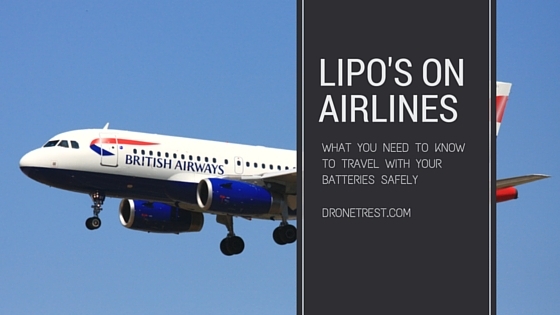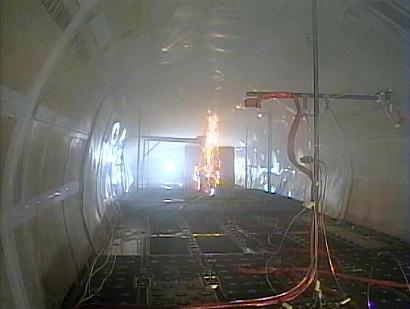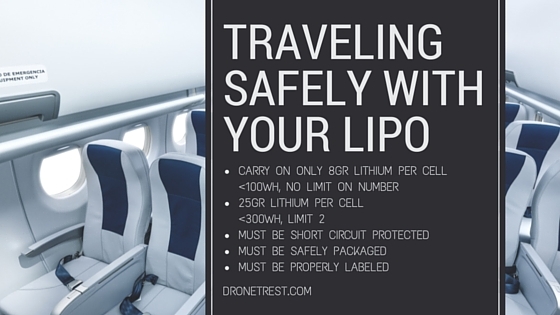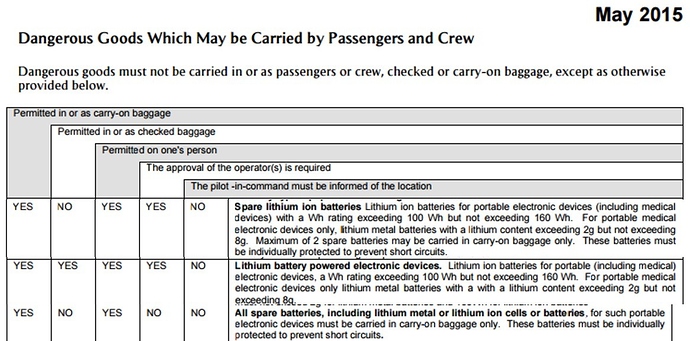
So having an aerial photography platform is awesome, but usually its the type of thing you want to take to new exotic locations to get some cool new shots, be it for business or pleasure. But there are some things you need to take into consideration when it comes to taking your Lipo batteries on domestic, or international flights. At the end of the day airlines want to avoid any risks and get your to your destination safely.

General Rules of traveling with LiPo Batteries
Although the general rules are similar, each airline seems to have its own policy in terms of battery rules so its a good idea to checkwith them before flying. However here are the general rules, although I have tried my best to make this information as accurate as possible you must first check with your airline/airport about the regulations as these might change over time.
Never travel with old Lipo Batteries - the older a battery is, the more likely the chance for a problem to occur, espeicialy if its not a quality brand name Lipo, so to be safe only ever travel with new batteries that have not had many charge/discharge cycles. I can personal suggest you only travel with GensAce TATTU batteries, since they all undergo the UN 38.3 battery test which is the highest quality standard test for lithium polymer batteries, something that most other manufacturers don’t test for. And yes if you are wondering, we do sell them at our shop so there is some bias towards them, but the reason we sell them is we believe them to be on of the best Lipo batteries ![]() .
.
IATA Dangerous Goods rules for LiPo Batteries
- LiPo batteries below 100Wh - bi quantity restrictions
- Between 100Wh and 160Wh - limited to 2 battery packs per passenger
- Above 100Wh - you are not permitted to travel with Lipos of this size as they are too dangerous if something went wrong.
How to calculate the Watt hour rating of a battery?
The Wh rating of a battery is based on the voltage and capacity of a battery. The IATA use the Wh rating as an estimation on the amount of lithium inside a battery and base their regulations on that.
Wh = number of cells x 3.7V x Amp Hours
So for a 3S 2200mAh battery would have a Wh rating of 3 x 3.7 x 2.2 = 24.42Wh so you would be able to travel with this battery as its under the 100Wh threshold.
Another example, lets say you want to fly with your gopro quadcopter, which most use a 3S 5100mah battery. The Wh rating for this is 3 x 3.7 x 5.1 = 56.61Wh which you can travel with too.
You only run into major complications when using batteries used on heavy lift multirotors such as 6S 10000mAh Lipos which have a Wh rating of 222Wh, which you can not travel with on airlines.
To learn more check our our Lipo battery guide
Wh Rating for common RTF drone batteries that you can travel with.
- DJI Phantom 2 - 59.94Wh
- DJI Phantom 3 - 68Wh
- 3DR Solo - 76.96Wh
- 3DR IRIS+ - 56.61Wh
- Yuneec Q500 - 59.94Wh
Always carry your batteries in a LiPo Safe pouch.
When you are traveling with the batteries always make sure to carry them in a Fireproof RC Li-Po Battery Safe. These bags are made from fireproof materials to contain any possible problem that could occur while traveling. Its always best practice to store your LiPos in such bags in general anyway, so its a good idea to get some if you dont have any.
Prepare the battery terminals
Another important thing to improve the safety is to insulate all of your battery terminal connectors. This adds extra protection incase they might come into contact with metal objects and short circuit. You can use some electrical Electric Insulation Tape, or shrink wrap.
Also you must also place each battery into its own Zip-lock plastic bag before placing them into your Lipo safe bag.
Discharge batteries to 40-50% (storage charge level)
Before taking your batteries onboard a flight, always make sure you discharge them to around 40-50% charge, or in otherwords they must be set to their storage level. Most Lipo Battery chargers such as the B6 has this feature to discharge you batteries to the optimum voltage for long term storage.
Always keep them in your hand luggage 
Since there have been previous cases of LiPo batteries catching fire its important to keep them in a place where you can monitor them. It is also a legal requirement to make sure your batteries are included in your checked luggage.
Optional: Add appropriate Labels to your batteries
Just in-case the airport security staff in unaware about LiPo battery regulations it might be a good idea to include a label on each plastic bag defining the specifications of the battery in IATA terms, or the IATA section 2.3.5.9 to be exact. The label should include the following information:
Complies with IATA section 2.3.5.9
- Battery Pack Chemistry: Lithium (Polymer) Ion
- Battery Pack Weight: 317g (11.2oz)
- Battery Pack Capacity: 3300mAh (3.3Ah)
- Cell Count: 4
- Total Battery Lithium: 3.96g - this you work out based on the fact that 100Wh battery contains 8g of lithum. To work this out :
8 / (100/battery wH)to get the approximate lithium content in your battery.
Contact your Airline and get written approval first
As already mentioned each airline has their own minor variation on battery rules, so its definitely worth checking with them before flying.
In all of my travels ![]() with LiPo batteries it always seems to depend on the airport security staff if they stop you or not. But in the cases when the security staff look concerned its always a good idea to have some written proof from the airline showing your correspondence. Taking a few extra minutes to send the airline an email first could make the difference between your lipos being confiscated or not.
with LiPo batteries it always seems to depend on the airport security staff if they stop you or not. But in the cases when the security staff look concerned its always a good idea to have some written proof from the airline showing your correspondence. Taking a few extra minutes to send the airline an email first could make the difference between your lipos being confiscated or not.
British Airways Specific Information
According to British Airways, they will require you to get their approval first before flying with LiPo batteries if they are over 100Wh so always just double check with your airline before flying!
Check information each time you travel
The final thing is that you should double check all the latest rules and regulations before you travel as these do change from time to time.

Following these rules you should have no hassles traveling with your drone batteries, and when you reach your destination you can get up into the air and start shooting some videos. However the other thing to check is also the local regulations on flying your drone which can be another entire article… If you have any of your own tips, or experiences please share them below!

